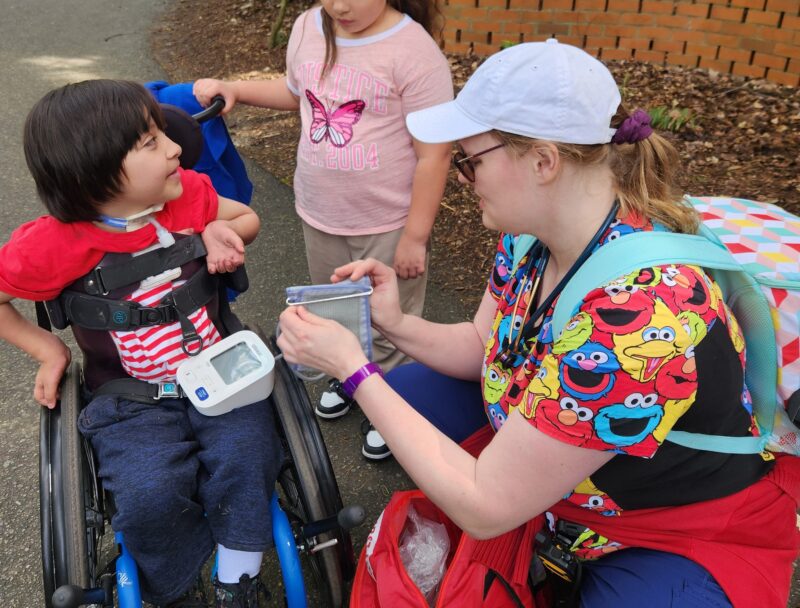
Respiratory Distress Syndrome (RDS) occurs when a baby’s lungs aren’t fully developed, causing breathing problems. It’s a common issue for infants born prematurely, so nurses for newborns will need to provide them with extra oxygen and breathing help. To keep your baby safe and healthy, below are steps you can expect to manage RDS.
Causes and Risk Factors of Respiratory Distress Syndrome
The common cause of RDS is when the baby doesn’t have enough surfactant in their lungs. It is a liquid that helps keep their lungs inflated and prevents them from collapsing. An infant usually starts to produce surfactant between 24 – 28 weeks of pregnancy, where they usually produce enough to breathe normally by 34 weeks. So, the earlier your baby is born, the more they’re at risk of developing RDS. Other common causes for RDs include:
- Transient Tachypnea of the Newborn (TTN)
- Meconium Aspiration Syndrome (MAS)
- Pneumonia and infections
Although most babies with RDS are premature, other factors also influence the risk of developing the disease, such as:
- Siblings born with RDS
- Cold stress
- Underweight
- Delivery complications (ex., cesarean section, perinatal asphyxia)
- Maternal health conditions (ex., diabetes, infection)
- Multiple births
Clinical Presentation and Diagnosis
The symptoms of RDS are immediately noticeable after birth. A child with this syndrome is believed to have blue-colored lips, toes, and fingers. It also has deep and rapid breathing, flaring of nostrils, grunting sounds when breathing, and chest retractions. To assess if your baby has RDS, doctors, and nurses for newborns perform tests such as chest x-rays, laboratory tests (ex., blood gases, CBC, and cultures), and echocardiography
Initial Stabilization and Management
Each baby will experience the symptoms differently, but they often peak 72 hours after birth before they get better. A registered nurse for babies may help stabilize your infant’s condition by:
- Placing them in a neutral or slightly extended neck position to maintain an open airway.
- Suctioning their mouth, nose, and pharynx to remove secretions that could block airways.
- Attach a nasal cannula under your baby’s nostrils for non-invasive oxygen support.
- Using a Continuous Positive Airway Pressure (CPAP) machine to provide extra breathing support.
- Utilizing a ventilator to send air into your baby’s lungs.
Preterm babies with RDS often only need breathing support for a few days. But if your infant is born extremely preterm, they may need breathing support for a few weeks or months. It’s best to consult with your doctor about your baby’s treatment plan so you know what to expect.
Surfactant Replacement Therapy
If your baby’s RDS symptoms persist, children’s nurses and doctors may need to provide them with surfactant replacement therapy (SRT). It’s a treatment that delivers surfactant until your baby’s lungs mature enough to produce the liquid on its own. Doctors supply the surfactant through a breathing tube to ensure it goes into your baby’s lungs. Depending on the severity of their condition, your baby may need to get this procedure done several times.
Administering surfactants within 2 hours after your baby’s birth provides better results, including reducing air leaks and chronic lung disease. Although administering several hours after birth can still be beneficial, it’s less effective than early treatment for reducing complications and improving survival rates.
Complications and Additional Therapies
Babies with RDS often develop complications due to the side effects of the disease, so nurses for newborns may need to provide them with additional therapy. Common complications of RDS include:
- Pneumothorax. Air leaks out of your baby’s lungs and gets trapped in their chest cavity. This can be treated by inserting a tube into their chest to release the air.
- Internal bleeding. Your baby may have bleeding inside their brain and lungs. It’s quite common for preterm babies and can be treated with a ventilator.
- Lung scarring. The ventilator or surfactant can cause lung scarring that can affect their development. Babies with severe lung scarring may need additional breathing support and medication to expand their airways to make breathing easier.
- Pneumopericardium. Air leaks into the sac surrounding your baby’s heart. Healthcare professionals treat this by decompressing the air with a needle or inserting a catheter to drain the air.
Infants with RDS will also need higher nutritional requirements to aid development, so they often have an Intravenous Catheter (IV) to get fluids, nutrition, and medicine. Doctors may also prescribe them with antibiotics if they suspect an infection or to help ease your baby’s pain during treatment.
Prevention and Risk Reduction
Preventing a premature birth is the best way to reduce the risk of RDS. You can avoid a premature birth by getting frequent prenatal care throughout your term and avoiding smoking, alcohol, and illicit drugs. Additionally, seeking support from nurses for newborns can provide valuable guidance and care.
If you’ll likely have a preterm delivery, pediatric health services may prescribe you with corticosteroids. The medication will help promote faster lung development and surfactant production for your baby.
Long-Term Management and Follow-Up
With the right treatment and medication, babies with RDS may not experience long-term effects and may even improve their quality of life. However, if complications occur, your baby is at a higher risk of developing:
- Asthma
- Respiratory infections
- Lung damage due to long-term ventilation
- Bronchopulmonary dysplasia
In this case, talk to your pediatrician for advice on the long-term management of your baby’s condition. Depending on their symptoms, your baby may need further testing, like eye and hearing exams, to ensure RDS hasn’t affected their development. Long-term management can feel overwhelming and stressful for you and your family, so don’t be afraid to reach out to a professional therapist or support groups to seek encouragement and help with dealing with the emotional strain.
Final Thoughts
Respiratory Distress Syndrome can be challenging to navigate. If undetected and untreated early, it can cause complications that can affect your infant’s development. Fortunately, with the right treatment and care from reputable doctors and nurses for newborns, your baby’s condition can hopefully improve. If you need help managing your baby’s RDS, speak with your child’s physician about pediatric caregiving support services like Nursing Evolutions. Our top priority is to ensure the health and well-being of our patients. We provide you with the best possible care and safety for your baby.
Frequently Asked Questions (FAQs)
Here are answers to common questions to help you understand how a neonatal nurse can assist with your baby’s condition:
What do neonatal nurses do?
A neonatal nurse is a healthcare professional that specializes in caring for newborn babies.
What are the goals of a neonatal nurse?
A neonatal nurse’s goal is to ensure each baby is safe and comfortable. They also provide constant monitoring and care to medically fragile infants, including administering special feedings and medication to help stabilize their condition.




